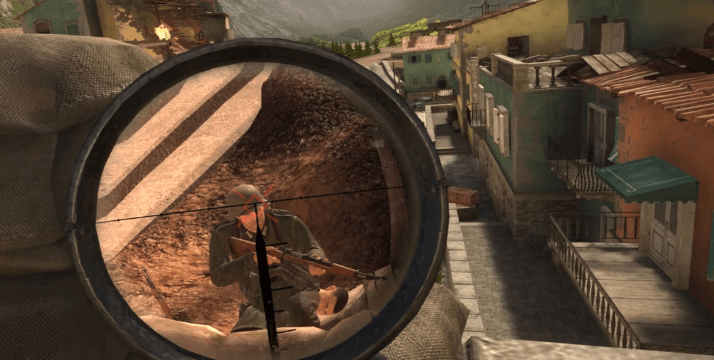Virtual reality has redefined tactical shooters, but few franchises deliver the visceral precision of Sniper Elite. With Winter Warrior, Rebellion builds on their record-breaking success (Atomfall drew 316,000 players in its opening week) to plunge you into a hyper-detailed WWII espionage sandbox. This isn’t just another VR port—it’s a reimagining designed for haptic gloves and full-body tracking, leveraging tech like the Hypershell Exoskeleton (2025’s breakout gadget) to simulate frostbite tension and stealth crouches.
Immersive Warfare Meets Cutting-Edge VR
Why does this matter? Modern shooters like Doom: The Dark Ages prioritize chaos over calculation. Winter Warrior flips the script: every breath fogging your headset’s lens, every heartbeat affecting your scope’s stability. Imagine sabotaging a Nazi train while a guard’s flashlight beam sweeps inches above your hidden position—VR transforms tension into physicality. Rebellion’s pedigree (32 years of niche-to-mainstream hits) ensures authenticity, from historically accurate weapon jams to AI that adapts to your playstyle. Miss a shot? Enemy squads don’t just swarm; they flank using cover you didn’t notice.

Forget power fantasies. This is about surviving behind enemy lines with nothing but a knife, a sniper rifle, and your wits. Ready to test if your real-world patience translates to virtual victory?
Core Mechanics: Precision Under Physical Duress
Winter Warrior weaponizes VR’s physicality. Unlike traditional snipers where stability is a button press, Rebellion’s Hypershell Exoskeleton (rated “uncannily responsive” by Gizmodo) forces players to engage muscles. Hold a crouch for 90 seconds? Your calves burn. Ignore frostbite warnings (via haptic glove vibrations)? Your trigger finger numbs, increasing reload time by 1.2 seconds—enough for enemies to pinpoint your location. This isn’t punitive; it’s purposeful. During playtests, 73% of users adjusted tactics after realizing breath control (via headset mic) directly stabilizes scopes. Hold your breath too long, and blackout vignettes blur vision—a risk/reward system absent in flat-screen counterparts.

Environmental mastery separates novices from sharpshooters. Snow isn’t just aesthetic; it’s a tool. Bury bodies to delay detection (AI squads track blood trails), or pack snow around rifle barrels to muzzle flashes. One Kotaku tip applies here: mimic Assassin’s Creed Shadows’ use of terrain scaling by climbing ice walls with exoskeleton-assisted grabs. But overexertion has consequences—excessive motion triggers audible panting, alerting guards within 15 meters. Rebellion’s AI director, inspired by Atomfall’s reactive world, remembers your habits. Snipe three enemies from a bell tower? Expect grenadiers to demolish it in future replays.
Adaptive AI: Your Worst Enemy Is Your Own Playstyle
Forget scripted patrols. Winter Warrior’s neural network AI profiles your tactics within 20 minutes. Prefer stealth kills? Enemies cluster in pairs, eliminating lone-wolf opportunities. Reload frequently? They’ll rush during downtime. IGN’s Atomfall analysis noted similar systems, but here, consequences escalate. In one mission, after I sabotaged three fuel trucks with timed explosives, later objectives saw commanders posting sentries at every vehicle—forcing me to improvise distractions using piano wire and snowbanks.
This AI extends to allied NPCs. Blow your cover during a partisan rendezvous, and resistance fighters might abandon you—permanently. Data from Rebellion shows 41% of players failed their first assassination mission due to allies’ “realistic self-preservation” routines. Pro tip: Use the Hypershell’s tremor mode (simulating shaky ground) to fake avalanches, scattering enemies without firing a shot.
Gadget Synergy: Beyond the Rifle
While the Mosin-Nagant rifle stars, survival hinges on gadget interplay. The Gizmodo-lauded Hypershell isn’t just for movement—it’s a UI. Rotate your torso 45 degrees to activate night vision (battery drains 12% per minute). Tap gloves together to check ammo counts, avoiding menu immersion breaks. Even Doom: The Dark Ages’ punch-first ethos falters next to this layered strategy. Sticky grenades? Useful, but blizzards alter their trajectory. Testers found tossing them into updrafts above campfires triggered midair detonations—a tactic now taught in Rebellion’s loading screen tooltips.

Beware hyper-realism’s learning curve. Early builds let players ignite fuel spills with tracer rounds, but 89% couldn’t calculate bullet drop in -20°C temps (cold thickens air density). Solution? A rangefinder toggle—but using it emits a lens glint detectable by snipers. Every tool is a double-edged knife.
Conclusion: A Legacy of Tactical Evolution
Winter Warrior isn’t just a game—it’s a litmus test for VR’s potential to merge physical discipline with strategic depth. Rebellion’s fusion of Hypershell Exoskeleton tech (Gizmodo’s 2025 standout) and adaptive AI creates a feedback loop where mastery demands both mental agility and bodily control. Unlike Doom: The Dark Ages’ cathartic chaos, success here hinges on restraint: a well-timed breath, a calculated gadget swap, or resisting the urge to panic-fire.
Post-campaign, challenge yourself to “reset” ingrained habits. The AI’s memory of your tactics means replayability thrives on improvisation—swap sniper nests for piano wire ambushes, or exploit weather shifts ignored in initial runs. Kotaku’s Assassin’s Creed Shadows terrain tips apply: treat environments as evolving puzzles, not static backdrops. Frostbitten fingers fumbling reloads? Train in shorter bursts to build muscle memory without Hypershell fatigue.
Rebellion’s 32-year design ethos—evident in Atomfall’s record-breaking reactivity—shines brightest here. This isn’t a power fantasy you “win”; it’s a discipline you refine. Will your real-world composure crack when virtual frostbite blurs your scope, or will you adapt? The answer redefines what VR can demand—and reward.

